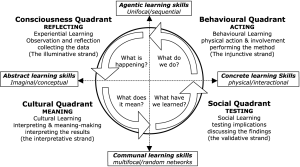Read the whole article.The Integral Learning Cycle and the Map
In a previous post I said I would go to into the metaphors within Wilber’s work combining my long-standing interest in his philosophical work with my new interest in metaphor theory.
For the (heavy duty) theoretical background to this piece, see this article by Mark Edwards on uniting the developmental and epistemological elements of Wilber’s Integral Theory.
Ken discusses three strands of knowledge—injunction (action), empiricism (experience arising from action), and confirmation/verification (knowledge sharing with the community of the adequate. He relates those to three famous philosophers/schools of philosophy of science. The first (injunction) is Thomas Kuhn and his work on Scientific Revolutions occurring through new paradigms–new practices. The second, the empirical school with roots in Democritus up through Hume and to the Positivist School. And lastly the third, verification being Karl Popper’s (justly) famous work on falsification. To which Edwards adds a crucial missing fourth: interpretation. Science (or here the act of understanding) always takes place within meaning and interpretative contexts. In philosophy of science, this view is associated with Paul Feyeraband.
By adding a fourth strand, we now have a correlation between the quadrants (the dimensions of existence in lines of development) and the ways of knowing. See the image above for Edwards’ connection of the two.
This learning cycle goes by many different names. The first version of it I’m aware of is the Ignatian Paradigm of the early Jesuit tradition: Action, Experience, Reflection (both philosophical-social and theological), leading to new action. Or Kolb’s learning cycle. Edwards’ article has a whole list of similar variations on the same fourfold theme.
Another version of which is the so-called OODA loop of military theorist John Boyd. Observation->Orientation->Decision->Act (which leads to new Observation and the cycle starts all over again).
Correlating OODA with the quadrants (as a cycle of knowledge) lends: Action (UR), Observation (UL), Orientation (LL), and Decison (LR). In this sense really an AOOD Loop.
The Orientation moment (the LL-interpretative strand) is the one I would like to focus on. Going back to the notion of Wilber’s primary metaphor as map, then we have the map of AQAL as an orientating wisdom. What Wilber in his earlier work called an orientating generalization. One of, if not the, primary experience according to Wilber of postmodernity is that of disorientation. Hence the need for a map. Recall that orientation/disorientation is itself a metaphoric interpretive position (position being another metaphor). I could have said an metaphoric interpretive impulse (over position)–notice the feeling-thought difference between impulse and position. The map as Wilber says is (using a sub-metaphor) psychoactive. It is not simply a theory but rather an injunction-experience-theory-confirmed (all four quadrants/strands again).
Offering multiple perspectives from many fields of human inquiry that may move all of us toward a more integrated understanding of who we are as conscious beings.
Pages
▼
Sunday, May 24, 2009
Chris Dierkes - The Integral Learning Cycle and the Map
Chris Dierkes takes an interesting look at Ken Wilber's integral theory in terms of metaphor theory - very fertile ground for exploration.
Tags:

No comments:
Post a Comment